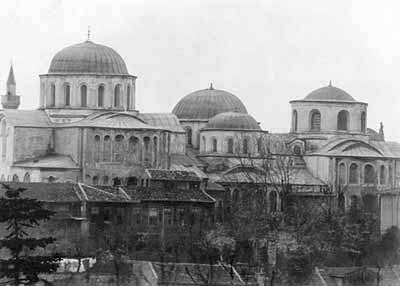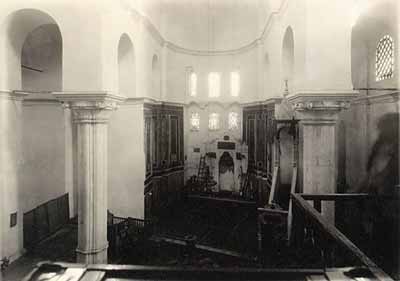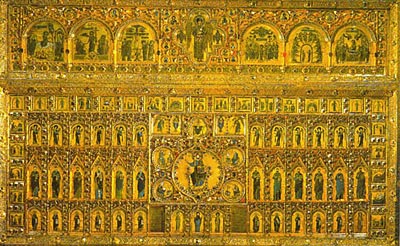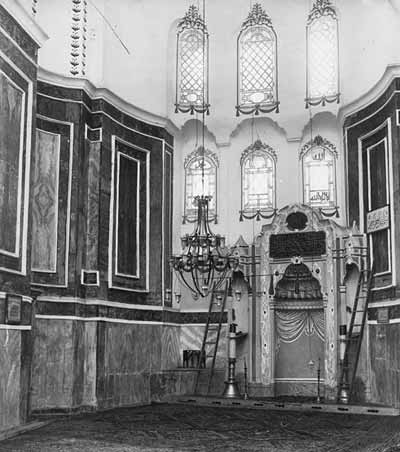History of the Pantokrator Monastery - Zeyrek Djami
above: The Pantokrator from an early 20th century picture showing the three churches with their respective apses.Many people date the beginning of the Byzantine Empire to the year of the founding of Constantinople of "New Rome" by the Emperor Constantine in the year 324 AD. The name "Byzantine Empire" is a recent creation, the inhabitants of this empire identified themselves as Romans or just Christians. Throught the years this empire grew and retreated in size as it was attacked by outside enemies east and west. In 1017 this empire suffered one of its worse setbacks when the Emperor Romanos Diogenes was defeated in battle by Turkish armies which had broken through the eastern frontiers. This setback allowed the penetration into the heartland of the Empire, Anatolia, by Islamic warriors who spearheaded the emigration of Muslim nomadic tribes.

above: Panel from Hagia Sophia showing John II and his wife Irene flanking the Virgin and Child. John and Irene, a blond Hungarian Princess, were the founders of the Pantokrator.
This crisis ended a long period of domination of Byzantium by a civil adminstration and lead to the overthrow of the current Emperor in Constantinople by Alexis Comnenos who placed his own provincial military aristrocratic family, the Comneni, in control with him as Emperor. The dynasty he created ruled the Empire from 1081-1204.
This period saw a broad economic regeneration and the recovery of a great part of Anatolia from the Muslim invaders. This recovery was not to prove lasting and the seeds of the destruction of the Empire and the Fall of Constantinople in 1453. Artistically and culturally the Comnenian period was marked by acceptance of outside influences - particularly from the west - and a renaissance of centuries-old traditions. Increasing prosperity and self-confidence lead the Comnenian Emperors to build new palaces, churches and other builkdings in the capital city of Constantinople

above: View looking into the apse of the south church. The Muslim minbar - pulpit - can be seen on the right had corner of the apse. This pulpit was made from the original canopied altar of the church.
One of their chief foundations was the complex of Monastery of the Pantokrator (Ruler of all), which was dedicated to Chist and stood on a hill overlooking the ancient aqueduct of Valens near the geographical center of the city. There are three interconnected churches. The first building was constructed by the Empress Irene between 1118 - 1124. This was the largest church and it was richly decorated with mosaics and rare marbles. Shortly thereafter a large church was built alongside the first one to the South and it was dedicated it to the Vigin Eleosa - "Mercy". Finally, a wide space between the two churches was vaulted over by two domes and transformed into an Imperial mausoleum dedicated to St. Michael the Archangel.

above: Looking northward from the large south church, through the mausoleum into the Church of the Virgin of Mercy.
The large south church is one of the largest churches built during the middle ages in Constantinople with a nave 52 feet square and a dome 23 feet across. The survivial of so many huge cathedrals in the capital, like Hagia Sophia and Holy Apostles, made the further construction of big churches unnecessary. The pietism of the time and the preference for smaller, community monastic churches also dictated a more intimate size.

above: Northwestern view from the Masoleum into the Church of the Vigin of Mercy
The splendid interiors of all three churches were must remarked upon in the Middle Ages. The Comnenian Emperors and their wives lavished money and gifts on the monastery, which was covered in golden mosaic, rich marble veneer, precious metals and semi-precious stones. Even the floor was inlaid with a fantastic opus sectile rinceau carpet of carved, colored marbles depicting mythological scenes, hunters and animals. Fragments of stained glass set in lead found in the church indicate the windows of the apse were set with figures of Christ, the Virgin and possibly other saints.

above: Plan of the three churches, The Church of the Virgin is on the left, the Mausoleum of St. Michael and the Pantokrator Church is on the right.
The mausoleum church contained many relics, including the stone upon which, it was claimed, Christ had been annointed after his crucifixion. This mausoleum was filled with the marble tombs of Emperors and Empresses and it's iconostasis was said to have been encrusted with gold enamels and gems.
The church was founded as a hospital and their were many beds along with nurses and doctors attached to the monastery. It was also a center of learning and art. The founding document for the monastery - its Typicon - survives and outlines all its social functions in detail.
In 1204 the city of Constantinople fell to the soldiers of the Fourth Crusade after a series of vast and horrible fires set by the Crusaders. These conflagrations leveled large swaths of the city and consumed art treasures and books created and gathered over 900 years by the Byzantines. This included some of the greatest works of antiquity and a vast part of Western civilization went up in flames. Catholic looters spread throughout the city to snatch what was left and the booty was thought to be the greatest ever seen.
The soldiers from France, Italy, and all across Europe did not spare the churches of their brother Christians, they stripped them bare of their valuables. The Pantokrator was attacked and looted. The tombs of the Emperoros and Empresses were opened and their bodies were stripped. Monks and nuns were murdered and raped. Tens of thousands perished.

above: The Pala d'Oro from St. Mark's in Venice. Many of the enamels and gems from the huge altarpiece are siad to come from the Pantokrator Monastery.
The Venetians claimed the Pantokrator as part of their booty and occupied the complex until the latins were ousted from the city by the Byzantines in 1261. Towards the end - when it became apparent they could not hold on to Constantinople it is said the Venetians removed the enameled panels from the iconostasis of the Pantokrator and shipped them to Venice, where they became the centerpiece of the famous Pala d'Oro.
After the recovery of the city of Constantinople by the Byzantines the monastery of the Pantokrator was restored and once again became a spiritual and cultural center. In 1453 the advancing Muslim Turks stormed the walls of Christian capital of the East. The city was looted, its citizens slaughtered and enslaved. The Pantokrator was looted once more and converted into a mosque - and renamed the Zeyrek Djami.

above: View of the apse of the south church. During Ottoman times the backwall of the apse was flattened and the mosaics were scraped off. The arch is a mithrab - it indicates the direction of Mecca for Muslim prayer. This view shows what remains of the magnificent marble paneling of the church.
Like many Byzantine churches that were converted into mosques the altar, iconstasis and portable ikons were removed, which the mosaics and wall paintings were curiously left exposed. This may have continued until the 18th century when the walls were scraped of their mosaics, leaving just a few fragments. At some point the valuable large columns of the north and south churches were removed and replaced with piers. The marble veneer of the walls was also stripped - leaving only the plackage of the apse to attest to the former glory of the Imperial church.
Today the church is undergoing restoration.
Bob Atchison